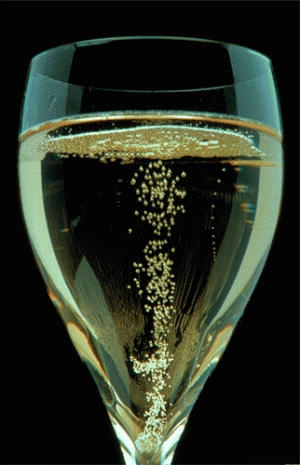The importance of fizz, more technically known as effervescence, in sparkling wines and champagnes is not to be underestimated—it contributes to the complete sensory experience of a glass, or flute, of fine bubbly. A scientist has now closely examined the factors that affect these bubbles, and he has come up with an estimate of just how many are in each glass. The report appears in ACS' The Journal of Physical Chemistry B.
Gérard Liger-Belair notes that effervescence plays an important role in the look, taste, aroma and mouth feel of champagne and other sparkling wines. Wine journalists and bloggers often cite 15 million as the average number of bubbles fizzing in a single glass of champagne, based on some simple mathematics. Sounds impressive, but Liger-Belair suspected that the formula leading to this estimate oversimplified the matter. It didn't take into account the fact that some of the dissolved carbon dioxide escapes from a glass without forming bubbles. Also, the size of the bubbles changes over time, and this could affect the final number. Liger-Belair wanted to set the record straight.
Taking into consideration temperature, bubble dynamics and the tilt of a flute, Liger-Belair came up with a new way to calculate the number of bubbles in a glass of champagne. And the result is far lower than what has been cited. "One million bubbles seems to be a reasonable approximation for the whole number of bubbles likely to form if you resist drinking champagne from your flute," he concludes. He also found that if you prefer more fizz in your bubbly, serve it warmer than you normally would and be sure to tilt the flute when pouring.
More information: "How Many Bubbles in Your Glass of Bubbly?" J. Phys. Chem. B, 2014, 118 (11), pp 3156–3163. DOI: 10.1021/jp500295e
Abstract
The issue about how many carbon dioxide bubbles are likely to nucleate in a glass of champagne (or bubbly) is of concern for sommeliers, wine journalists, experienced tasters, and any open minded physical chemist wondering about complex phenomena at play in a glass of bubbly. The whole number of bubbles likely to form in a single glass is the result of the fine interplay between dissolved CO2, tiny gas pockets trapped within particles acting as bubble nucleation sites, and ascending bubble dynamics. Based on theoretical models combining ascending bubble dynamics and mass transfer equations, the falsely naı̈ve question of how many bubbles are likely to form per glass is discussed in the present work. A theoretical relationship is derived, which provides the whole number of bubbles likely to form per glass, depending on various parameters of both the wine and the glass itself.
Journal information: Journal of Physical Chemistry B
Provided by American Chemical Society




















